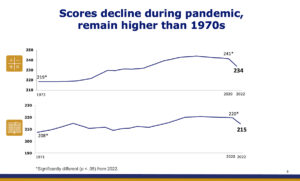Last week I spoke with Dr. Marcheta P. Evans, the new president of Bloomfield College, whose inauguration is today. Dr. Evans was most recently the Provost and Vice President for Academic Affairs at Lady of the Lake University in San Antonio, Texas, and has spent her life in education. As a Black woman in the largely white and male-dominated field of academic leadership, she has a history of overcoming obstacles and anticipates turning Bloomfield College, currently struggling with a graduation rate of 33%, into a “community committed to student success.” Here is an edited version of our conversation.
Laura: Why don’t you tell me about your background? Where did you grow up?
Dr. Evans: I grew up in Alabama in the ‘50’s and ‘60’s during the Civil Rights era. We were a very education-focused family. My grandmother would say, “once you get an education they can’t take that away from you.” I was raised in the church, so public service was one of my family’s most important values. And my house was the community house, where all the kids would play and my grandmother would feed everyone. With that mentality, you know you must go to school!
Laura: Where did you go to college?
Dr. Evans: I graduated from the University of Alabama with my Ph.D. — my dissertation was entitled, “Faculty Attitudes Toward African-American Doctoral Students in Colleges of Education: A National Study”– and received both my Bachelor’s and Master’s degrees there. I started college as a freshman with an interest in biology and chemistry but I decided to focus instead on psychology and history. This was a natural fit for me — my family primarily works in public service like education and nursing and my mom was a nurse on a psych ward for the criminally insane in Washington, DC.. Sometimes as a little kid I’d sit in the ward doing my homework and I’d wonder, “what triggers someone to do this criminal behavior?” In fact, my first M.A. — I have two — was in Rehabilitation Counseling.
I decided to go into school counseling, to help parents and their children navigate the system. I’d counsel families where the child had a label of mental retardation [MR] — that’s what they called it then — and help them see possibilities and access resources. Do you need help preparing for a job interview? How about extended time on tests?
But I was also very aware of discriminatory practices. I would go to white, wealthy areas of Alabama and see a child classified with a learning disability. But in inner Birmingham that same child would have been classified as MR. I remember one district in Mountainbrook where there was one African-American student in the whole system. I’d walk in and give my spiel on vocational services and they’d stare at me as if they’d never seen a Black professional. But in Birmingham the parents didn’t want their kids classified for special education.
This is one example of many inequities I saw embedded in the system and I became more invested. That’s when I went back and got my second Masters in elementary education and a Ph.D. in counselor education and supervision. I wanted to teach counseling because there were so few people in leadership positions who looked like me and I wanted to expand the field of inclusive education. That’s my passion. At the same time I knew I had to check all the boxes.
Laura: What do you mean by that?
Dr. Evans: Well, for example, I first became a faculty member at Auburn University in Montgomery, Alabama. Most of the academic administrators were white men. Some women would get to the associate professor level but never reach a full professorship. I became committed to becoming an academic administrator so I could show other people of color, especially women of color, that you can do this too! I started out as an assistant professor at Auburn University, became an associate professor, department chair and associate dean at the University of Texas at San Antonio [UTSA], and eventually became Dean and was promoted to full professor and Chief Academic Officer and Provost at Our Lady of the Lake University. I was checking off all the boxes so I could become a college president.
If I can get in the door I can show you my passion. But in order to get through that door I had to have the right set of accomplishments.
Laura: What led you to Bloomfield College?
Dr. Evans: At first it wasn’t even on my radar. UTSA is 30,000 students! I was looking for a school with a largely minority population and, look, I’m a faith person — I think we’re here for a reason. A search firm encouraged me to look at Bloomfield College. I had interviewed for other college presidencies. If you’ve ever had an interview committee look at you like,”what makes you think someone who looks like you could be president of this school?,” you’d look farther afield too.
Anyway, I was at an academic conference and I start chatting with a person who was from Bloomfield College! God has a sense of humor when those types of things happen. You might think you need to go in one direction, but God has another plan if you listen. So, I listened and went to visit for an interview and fell in love with the place. This is a school that is struggling with enrollment but I love a challenge. And I know how transformative education can be.
Laura: Can you tell me about the students at Bloomfield?
Dr. Evans: Our students are almost all Black and brown and 70% are first generation college students. Seventy-five percent are eligible for PELL grants.
Laura: Bloomfield has a low graduation rate, only 33%.
Dr. Evans. Yes, we have many challenges, although that rate only includes students who started as a freshman and we have quite a few transfer students. For starters, I’ve started working with our community on a new strategic plan — the old one didn’t add value — and initiated a series of listening tours and surveys with alumni, students, faculty, and the Bloomfield community. From that collective feedback We’ve established five preliminary initiatives.
Laura: What are they?
Dr. Evans: First, we will create a community committed to student success, one that enhances our community core values. What is the identity of Bloomfield College? What are the values we espouse?
Second, we have to grow and diversify our revenue streams. As a private, independent college we are tuition-driven. This doesn’t work: We can’t afford to depend solely on tuition. What are other options? Should we expand our housing, create new graduate programs? Our current ones are low-enrolled, like our MFA program.
Third, we must improve our student success and graduation rates. As part of my on-boarding, I created a list of peer institutions based on demographics with 12 different variables. Compared to these other colleges we’re not that bad but that’s just giving me the baseline. My five-year plan includes a goal of moving our 64% retention rate — how many freshmen re-enroll as sophomores — to 72%.
Fourth, I want to increase the rate of student satisfaction and change the narrative. Our kids come in with such resiliency, many with histories of homelessness and food insecurity (we’ve already created two on-campus food pantries) and foster care. We want them to have a full college experience. With this comes branding. We want pictures on our walls that show students feeling valued and embraced. We’ll also establish strategic partnerships to grow student enrollment, perhaps affiliating with other institutions so that students can, for example, spend three years here, transfer somewhere else for two years, and graduate with both a Bachelor’s and Master’s degree. I’m also looking at growing our programs for international students, particularly those from South Korea, and creating online programs.
Fifth, we must invest in academic innovation and inclusive excellence that focus on our mission. We’re talking about developing a criminal justice degree with a restorative justice slant. We want to be sure that our students can get jobs once they graduate. Look, I’m a mother of six. You spend all this time and money; you need to move directly into employment. We’ll have a career center with mock interviews starting in the sophomore year. We’ll have internships so potential employees can see our students’ work ethic and know that a Bloomfield College graduate is someone who can hit the ground running.
Laura: That’s an ambitious plan!
Dr. Evans: It has to be. We want K-12 teachers from surrounding communities like Newark and East Orange to bring their students here and know this is a community where they are valued and where they belong. We’re sometimes referred to as a “hidden gem.” We’ll remain a gem but we’re determined to stop hiding! This is what our students need.



